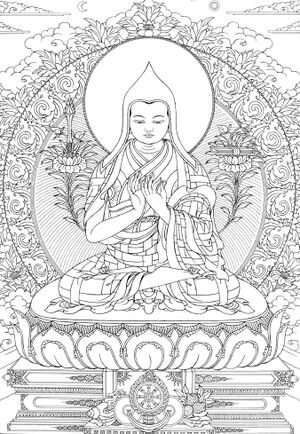The Theory of Spiritual Gene (gotra, rigs) in Tsongkhapa's Golden Rosary[edit]
The Golden Rosary, a commentary on Maitreya's Ornament of Clear Realization, is the first major output of Tsongkhapa, finished in 1388 in Nyethang Dewachen. Like many Indian and Tibetan commentators before him, Tsongkhapa saw the importance of the Ornament of Clear Realization as a core classic for the study of perfection (pāramitās, ཕར་ཕྱིན་). This text reveals in detail the layout of the Mahāyāna soteriological path, which was taught only covertly in the Perfection of Wisdom sūtras. Thus, it had come to be in Tsongkhapa's time one of the four main topical classics a scholar had to master, and in later times, one of the five doctrinal classics.
One of the important topics in the Ornament of Clear Realization is the basis of Mahāyāna practice, the spiritual gene or potential. While discussing this concept of spiritual gene in his Golden Rosary, Tsongkhapa presents three theories on the nature of the spiritual gene.
The first theory of the spiritual gene is of the śrāvaka (ཉན་ཐོས་) disciples, who, according to Tsongkhapa, identifies it with the sense of contentment in having modest robes, alms, beddings, and with the joy in renunciation and meditation. In brief, as Vasubandhu has stated in his Abhidharmakośa, the spiritual gene is the disposition for nonattachment or desirelessness (alobha, མ་ཆགས་པ་), which leads to the state of sublime beings. He rejects the theory some scholars propound that the sūtrāntika accepts a spiritual gene which is the ability of a being to abandon obscurations.
The second theory he presents is of the Cittamātra school, in which there are in fact two different theories of the spiritual gene as a conditioned phenomena and an unconditioned nature of reality. The conditioned spiritual gene is also of two types: the naturally present one and the developed spiritual gene. The naturally present gene is the capacity found in the store consciousness to give rise to undefiled qualities, though it is not of the same nature as store consciousness. This is, therefore, a conditioned phenomena. When this naturally present spiritual gene is enhanced through study, reflection, and practice, it is given the label of being a developed or properly cultivated spiritual gene.
Tsongkhapa further explains that such a concept of a conditioned spiritual gene is also tenable in systems which do not accept the concept of store consciousness. In that case, the spiritual gene is identified with the aspect of the internal sense-consciousness, which is inherited from beginningless time by nature (ཐོག་མ་མེད་པའི་དུས་ཅན་ཆོས་ཉིད་ཀྱི་ཐོབ་པ་) and gives the capacity to attain enlightenment (བྱང་ཆུབ་ཐོབ་པའི་ནུས་པ་). Like above, while this capacity or aspect rests in the sense-consciousness, it is not the same as the sense-consciousness.
Some Cittamātra proponents such as Śāntipa, Tsongkhapa claims, hold the spiritual gene to be the unconditioned nature of reality as presented in the Ornament of Clear Realization. In this case, the spiritual gene is not a direct cause of the resultant qualities of enlightenment, as is the case in the theory of the spiritual gene as a conditioned phenomena, but it serves as an object, which, when realized properly, engenders enlightened qualities.
The third theory that Tsongkhapa presents is that of the Middle Way school, in which one also finds the term being used to refer to two different things. In some texts, such as the Sūtra of Ten Dharmas and Candrakīrti's Entering the Middle Way, Tsongkhapa points out that the term gotra, or spiritual gene, refers to the Mahāyāna disposition which gives rise to certain external behavior of bodhisattvas. Yet in other sūtras, he says, the spiritual gene is identified with the dharmadhātu (ཆོས་དབྱིངས), or sphere of reality, as done in Maitreya's Ornament of Clear Realization. If asked what kind of sphere of reality is the spiritual gene, Tsongkhapa explains that the sphere of reality refers to four or two categories which are taught in the Ultimate Continuum. He further clarifies that the Mādhyamika scholars, in the conventional sense, give the designation of the naturally present spiritual gene to the nature of the mind (སེམས་ཀྱི་རང་བཞིན་), which is emptiness without any real existence. When such an emptiness is realized, in conventional terms, illusory apprehensions in their entirety are removed and illusory antidotes in their entirety arise.
In contrast, the Cittamātra scholars, Tsongkhapa claims, accept the luminous nature of the mind to be eternally and truly existent and that it serves as a basis for the removal of adventitious impurities and the attainment of the enlightened qualities. He remarks that the former (i.e., the Mādhyamika) argument seems to be what the Ornament of Clear Realization expounds, while the latter (i.e., the Cittamātra) position seems aligned with what the Ultimate Continuum presents. Is Tsongkhapa, then, suggesting that the Ultimate Continuum presents a Cittamātra theory of spiritual gene as a truly existent luminous nature of the mind? This is not clear. But what is amply clear is that Tsongkhapa rejects that there are beings deprived of a spiritual gene, as it would entail that impurities, if they cannot be abandoned, are in the nature of the mind. According to him, those who are said to be deprived of a spiritual gene in the sūtras merely refer to those who have more difficulty reaching liberation (གྲོལ་དཀའ་བ་ཙམ་ལ་དགོངས་).
Weekly quote[edit]
~

